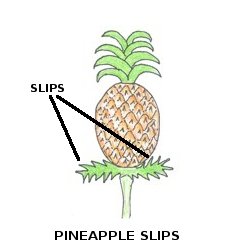What are pineapple slips and what differentiates a slip from a sucker? Slips & suckers, A slip emerging at base of a pineapple. Suckers are little plantlets that grow between the leaves of a mature pineapple (take most off when about 8″ long). Slips are tiny plantlets that grow at the base of the fruit on the fruit stalk.
Not all pineapple varieties produce slips, Every 2-3 months and take off all the big suckers I see. Grab hold of them as close to the base as possible, twist & pull at same time. They usually come off easily. Plant them like you plant tops. Source
Pineapple Slips: General Requirements
Temperature Range: 65 °F – 95 °F.
Rainfall: 60 cm/year (at regular intervals throughout the growing season).
Soil Type: Well-drained and acidic soil (4.5-5.5 pH).
Propagation: Crown, suckers and slips.
Flowering: Requires cooler temperatures.
Propagation Method
The propagation of pineapple plants is mostly carried out by means of crowns. Seeds are not preferred owing to their slow growth. Other parts of the plant such as ‘slips’ and ‘suckers’ are also used for propagation. While preparing the crown for propagation, its lower leaves are peeled off to expose the ‘root primordia’. Crowns are then planted in a potting soil known as ‘Bromeliad Potting Soil’. Then the plants are grown in pots for few days before moving them in fields.

Sucker Propagation
Planting suckers allow fast growth of pineapples in comparison to the traditional method of planting the crown. For this, you need to first identify them and learn to pick them. Suckers are found between leaves of fully-grown pineapple plants. They can be pulled out with the hand; you just have to twist them at their base. It also prevents the plant (sucker) from getting hurt. Rest of the procedure for growing pineapple plants is same as that used in the traditional method.

Slip Propagation
Slips can be found at the base of pineapple fruits. These are tiny plants not found in all varieties of pineapples. The Smooth Cayenne and Rough Cayenne are commonly used for growing pineapples from slips. You can pull and plant the slips just like suckers. The method used for growing pineapples from slips is same as the traditional one.

Crown Propagation
It is the most common method of propagation in pineapples. The crown is pulled or cut off from the fruit and kept for rooting for about 3 weeks after which short roots emerge. The crown can then be used for potting in the house or field cultivation.
Field Cultivation of Pineapple
Climate and Soil Requirements of Pineapple
The pineapple plants grow well in a temperature ranging from 65 °F to 95 °F. Although it can tolerate cold temperatures for a short period during nights, the growth gets stunted and fruits become acidic when it is exposed to lower temperatures for a longer time. Well-drained and friable soil, rich in organic matter is considered as best for growing pineapples. The pineapple plants grown at high altitudes bear acidic fruits.
Planting
Before planting, pineapple fields are well-prepared to suit this shallow rooted plant. Crowns prepared for plantation are sown at a depth of 10 cm in double-rows. A distance of 25-30 cm. is maintained between two plants, while two double-rows are kept 0.9-1.8 m apart. Mulching is used in pineapple fields for conserving soil moisture, maintaining the necessary temperature of soil and also for controlling weeds. In the mulching activity, entire field is covered with plastic sheets or bagasse (sugarcane pulp) is used.
Fertilizer Application
Nutrient requirements of the pineapple plant change across different regions. Like any other crops, pineapples too require nitrogen in greater quantities than any other soil nutrient. In Kenya, 472 kg nitrogen per hectare is used in the first year in 4 equal parts. For acidic soils, the application of magnesium sulfate proves to be beneficial. It is applied at a rate of 327 kg/ha in sandy-clay soils of Puerto Rico. Chelate is actually a chemical compound in which a metal atom is bound by other atoms. Iron, when applied with nitrogen in a chelated form, increases the crop yield as well as the fruit size.
Irrigation and Weed Control
For the cultivation of pineapple plant, irrigation is required only in the dry months of summer. Manual weeding is not recommended in pineapple fields, since it proves to be expensive and can also lead to soil erosion. Practice of mulching is the best option for controlling weeds.
Flowering
Induction of flowering is undertaken to control the time of harvest and maturity in pineapples. Use of chemicals to control the natural and ‘organic’ growth of any plant is artificial and unnatural; however, cultivators tend to practice it to avoid excessive fruit production during peak periods. Earlier, ethylene gas was commonly used to control the fruiting process. Today, hormones such as a-naphthaleneacetic acid (NAA) are used. When a pineapple plant is 6 months old, it is treated with hormones to induce flowering.
Pests and Diseases
Care of pineapple plants becomes important in order to protect them from pests and diseases. Controlling the nematodes is necessary because they stunt pineapple growth. 1,3-dichloropropene or 1,3-D is efficient in controlling the nematodes and is applied using the fumigation process. In this process, the soil is smoked. Mealy bugs which cause the wilting of pineapple leaves are controlled by spraying pesticides. The fire ants which carry mealy bugs from one plant to another need to be controlled in this case. Root rot disease is controlled by improving soil drainage and fungicide application.
Harvesting
Summer fruits of pineapple mature early as compared to the winter ones. To know if the summer fruits are ready for harvesting, check whether the pineapple’s ‘eye’ is pale green. In the winter season, fruits turn light yellow at the base and are considered as ready for harvesting. For pineapple fruits to be ‘canned’, it is necessary to harvest them when fully ripe.
The activity of pineapple cultivation requires in-depth knowledge of different stages of growth of this plant. With proper care and maintenance you can grow pineapple in fields as well as in the indoor environment.
*******PINEAPPLE SUCKERS (Hybrid) For Sale******
* Quality Improved Variety
* High Yielding: 2kg/fruit
* Maturity: 14 months
* Fruits are also available for sale
Kindly send your orders to info@sabiagrik.com
Watch videos HERE
Read Is a business Plan Essential for my Small Business? Click to read

3 Responses
I wish to know the location of your hybrid pineapple suckers and crown, cost/sucker or crown and the quantity available.
Nice piece…but I wish to know the location of your hybrid pineapple suckers, the cost per sucker the quantity available and how I can order and make payments for the order. Thank you
We are a chat away @sabiagrik (twitter, FB & Instagram)